In what is expected to be an almost unprecedentedly close American League, where every team has a realistic shot at making the postseason, each potential pitfall will be magnified for every AL squad in 2016. The Red Sox are, of course, no exception, and have plenty of questions marks on their roster. Jackie Bradley represents one of them. Or, more specifically, his bat represents one of them.
I’ve said previously in this space that Bradley’s offensive performance might not ultimately matter, and I stand by that. With that being said, other things will have to go right, and no one will deny that everyone is better off in a world in which Bradley hits.
Luckily, he has shown flashes of being a successful hitter at various points in his professional career. Although most of that has come against minor-league pitching, he was on another planet for a stretch in the second half last season. Besides that stretch, however, Bradley’s been Bad against major-league pitching. The main reason for these struggles has been strikeouts.
Over his 785 career plate appearances, the soon-to-be 26-year-old Bradley is the owner of a strikeout rate over 28 percent.
Over his 785 career plate appearances, the soon-to-be 26-year-old is the owner of a strikeout rate over 28 percent. Players have succeeded while striking out that often before, but it requires a power tool that Bradley just doesn’t possess. What’s worse is, even during his out-of-this-world stretch last August, he still carried a strikeout rate of 26 percent.
Assuming he’s not going to be a modern-day Barry Bonds like he was during that month, there’s just no way around it: Bradley needs to cut down on all the strikeouts if he’s going to be a legitimate major-league hitter. The first step in correcting that is looking at how pitchers are successfully attacking him, both in terms of location and pitch type.
To do this, I went over to Brooks Baseball, and first looked to see if there were differences in how lefties and righties attacked him. Although Bradley has shown reverse splits over his short career, he strikes out at a near-identical rate regardless of his opponents’ handedness. As a closer look reveals, both types of pitchers have different go-to offerings against Bradley.
Right-Handed Pitchers
To say Bradley has had troubles against right-handed pitching would be an understatement, as he has a .229 multi-year TAv against them. His right-handed opponents use two pitches to defeat Bradley: changeups and curveballs. The latter is used a bit more in two-strike counts, but both result in whiffs on roughly 40 percent of his swings. Some #analysis on that: It is Super Bad.
Changeups aren’t an uncommon pitch for hitters — particularly young ones — to struggle with against opposite-handed pitchers. It’s the kind of pitch that allows hurlers like Cole Hamels to post reverse splits. To get a better idea of how Bradley is undone by these pitches, the following gif will alternate between raw pitch locations, swing rates in the zone and the percentage of whiffs on that swing.
A few things stand out about this. Clearly, pitchers are attacking Bradley down and away with changeups. Of course, that’s not really all that surprising. Most pitchers attack most hitters in that location with this kind of pitch. Unfortunately, he hasn’t shown any ability to lay off these pitches, particularly the ones that fall out of the zone. As is clear in the final part of the gif, it’s nearly impossible to make contact with a changeup that is falling down and out of the zone.
Beyond the changeups, right-handers have also attacked Bradley with curveballs. I won’t waste time reiterating everything I said above, but the same general issues exist with this pitch. Pitchers are attacking him down, he’s having trouble laying off those offerings that dip below the strike zone, and predictably, can’t make contact. Here’s a gif for you visual learners.
Left-Handed Pitchers
On the one hand, southpaws haven’t had as much success against Bradley as their right-handed counterparts. He’s currently the owner of a respectable, multi-year .271 TAv against them. On the other hand, he’s still striking out 28 percent of the time against them, and most of his success has been the result of a .335 BABIP.
Lefties have relied on breaking balls against him, with the curveball appearing again along with sliders coming in at an almost identical rate. In fact, not only are sliders they thrown to Bradley at an equal rate, but they both induce whiff rates around 40 percent. (There’s that number again!) Although the handedness of the pitcher has changed, the strategy has not. The breaking balls are coming in down in the zone, Bradley isn’t laying off, and he’s whiffing at everything below the bottom of the zone.
The Equalizer
So, we’ve identified how pitchers of each handedness attack Bradley, and it’s mostly the same, just with different pitchers. They’re getting him to chase too many pitches down and out of the zone, and he’s been unable to even foul those pitches off, much less lay off them.
Of course, intuitively we know that most of these pitches come at the end of his at-bats. Towards the beginning of his at-bats, he’s been attacked with fastballs. His whiff rate against these pitches is 25 percent, which still isn’t great but looks a lot better compared to the other pitches. Unfortunately for Bradley, he fouls almost half (44 percent) of these pitches rather than putting them in play. Looking at one final gif — this time highlighting these fastballs — will show exactly why this is such a problem.
Whereas the off speed and breaking pitches are coming in the bottom of the zone, the fastballs are coming up high. Typically, fastballs up in the zone give a hitter more opportunity to make hard, solid contact. With Bradley fouling so many of these pitches off, however, it has the negative effect of altering his eye level. Low breaking balls are hard enough to hit. Allowing pitchers to start you off with high fastballs without much fear of real damage only makes it that much more difficult.
***
In the end, pitchers aren’t getting their strikeouts against Bradley with any clever or surprising plan. The good news is there are two ways for him to counteract his opponents’ strategy. First, he can dedicate his practice time to fighting off those breaking ball and off-speed pitches. Showing that he can foul off those offerings will force pitchers to find a new strategy against him. Of course, that’s much easier said than done.
What should be easier would be to put the ball in play earlier in counts against those fastballs. Pitchers are taking advantage of simple sequencing against Bradley, and it’s because he can’t punish these early-count fastballs. If Bradley’s ever going to be a successful hitter on a consistent basis, he needs to strike out less. If Bradley’s ever going to strike out less, he needs to make the proper adjustments to counteract how pitchers are approaching him.
Photo by Andy Marlin/USA Today Sports Images
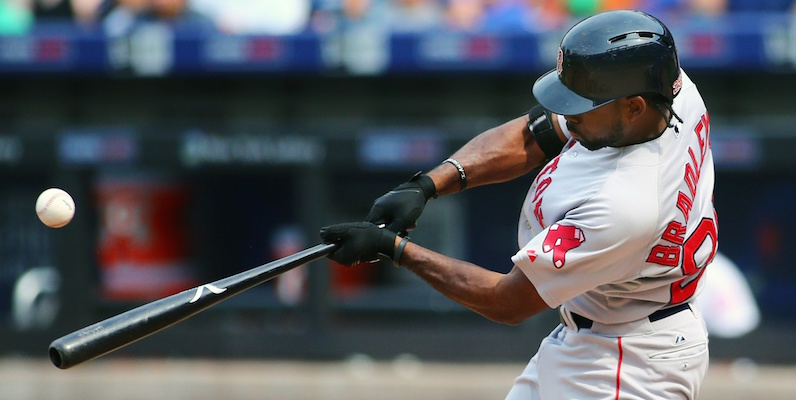
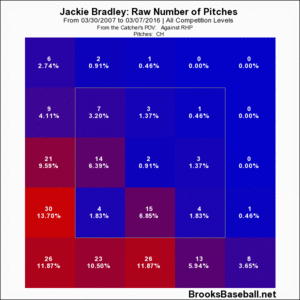
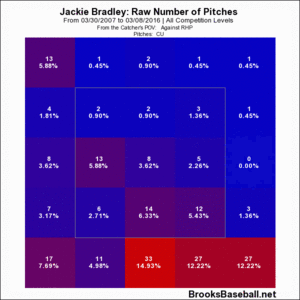
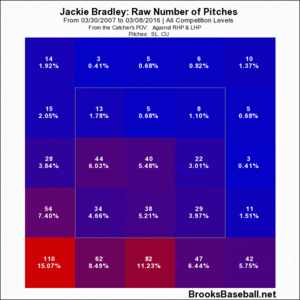
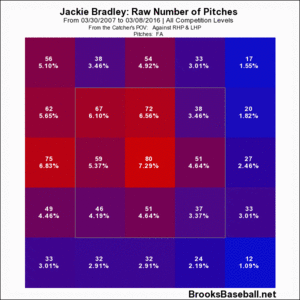
Forget all these analytics. The bottom line is this: We KNOW that when Bradley plays in the outfield, fly balls go there to die. His offense has been a question mark, but if he just hits around .250, with 15-20 HRs, pretty much any team would take that, with the glove, and be very happy. If he hits above those marks, then the Sox will have one hell of a player.